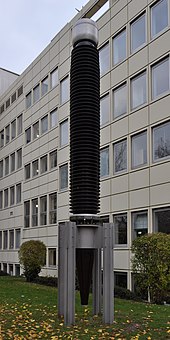Implementation (electrical engineering)

A bushing , also referred to as a housing insulator , in electrical power engineering is an electrical conductor which is encased by an insulator material and which is used to insert and lead electrical lines into a building or into a larger housing. Depending on the design, the implementation consists of various insulation materials, for example a ceramic block in which the metallic conductor is incorporated; it protrudes at both ends to connect the incoming and outgoing overhead line . Often, especially in the area of bushings that are operated with high voltage , an additional surge arrester is attached to the outside .
Bushings are, among other things, components of wall connections and occur, among other things, in compact substations housed in buildings or on the housings of power transformers . The design of the spark plug in motor vehicles is also a housing insulator. Depending on the number of electrical lines, the bushing can have one or more poles. For the three-phase alternating current common in electrical power engineering, three spatially adjacent bushings are required.
There are also asymmetrical bushings in which, for example, one end is used to connect a high-voltage cable , while the other side is used as a cable termination and transition to an overhead line. In the high-voltage area, the potential control inside the bushing plays an important role in order to avoid undesired partial discharges and the associated material fatigue. In the case of bushings operated with high DC voltage , such as high-voltage direct current transmissions (HVDC), the potential is controlled by additionally introduced weakly conductive materials within the actual insulator material.
literature
- Andreas Küchler: High voltage technology . 2nd Edition. Springer, 2005, ISBN 3-540-21411-9 , Chapter 7.1.2 Implementations.

